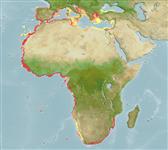Elasmobranchii (tubarões e raias) (sharks and rays) >
Myliobatiformes (Stingrays) >
Myliobatidae (Eagle and manta rays)
Etymology: Aetomylaeus: Greek, aetos = eagle + Greek, mylio = mill, grinder (Ref. 45335).
Environment: milieu / climate zone / depth range / distribution range
Ecologia
marinhas; estuarina bentopelágico; intervalo de profundidade 10 - 150 m (Ref. 6808). Subtropical; 44°N - 35°S, 19°W - 36°E
Eastern Atlantic: Portugal and Morocco to Angola, including the Mediterranean, Madeira and the Canary Islands; then from Saldanha Bay to Natal (South Africa) and southern Mozambique (Ref. 5578).
Comprimento de primeira maturação / Tamanho / Peso / Idade
Maturity: Lm 90.0, range 35 - 148 cm
Max length : 222.0 cm WD (female); common length : 150 cm WD macho/indeterminado; (Ref. 57025); peso máx. publicado: 116.0 kg (Ref. 85836)
Descrição suscinta
Chaves de identificação | Morfologia | Morfometria
Long, flat, rounded snout like a duck's bill; head thick and pectoral disc with sharply curved, angular corners; upper or lower jaw; usually with 7 rows of flat teeth (Ref. 5578). Light brown with several pale blue-grey stripes (may be absent) dorsally, white ventrally (Ref. 5578).
Found in coastal tropical and warm temperate waters, occasionally offshore. Sometimes found in small groups (Ref. 5578). Feed on bottom-living crustaceans and mollusks. Ovoviviparous (Ref. 50449), aplacental (Ref. 57025). Prized angling fish, often released (Ref. 5578). Flesh highly esteemed (Ref. 3965).
Exhibit ovoviparity (aplacental viviparity), with embryos feeding initially on yolk, then receiving additional nourishment from the mother by indirect absorption of uterine fluid enriched with mucus, fat or protein through specialised structures (Ref. 50449). Gestation about 6 months; 3-7 young produced (Ref. 5578). Size at birth 45 cm WD (Ref. 6677).
White, W.T., 2014. A revised generic arrangement for the eagle ray family Myliobatidae, with definitions for the valid genera. Zootaxa 3860(2):149-166. (Ref. 97392)
Status na Lista Vermelha da UICN (Ref. 130435: Version 2024-2)
Ameaça para os humanos
Harmless
Uso pelos humanos
Pescarias: espécies comerciais; peixe esportivo: sim
Ferramentas
Relatórios especiais
Baixar XML
Fontes da internet
Estimates based on models
Preferred temperature (Ref.
123201): 13.7 - 24.5, mean 17.2 °C (based on 196 cells).
Índice de diversidade filogenética (Ref.
82804): PD
50 = 0.5078 [Uniqueness, from 0.5 = low to 2.0 = high].
Bayesian length-weight: a=0.00389 (0.00119 - 0.01269), b=3.08 (2.83 - 3.33), in cm total length, based on LWR estimates for this (Sub)family-body shape (Ref.
93245).
Nível Trófico (Ref.
69278): 3.8 ±0.57 se; based on food items.
Resiliência (Ref.
120179): Muito baixo(a), tempo mínimo de duplicação da população maior que 14 anos (Fec=3).
Fishing Vulnerability (Ref.
59153): Very high vulnerability (83 of 100).
Nutrients (Ref.
124155): Calcium = 6.08 [0.77, 110.95] mg/100g; Iron = 0.496 [0.044, 5.834] mg/100g; Protein = 20.6 [15.3, 25.8] %; Omega3 = 0.146 [0.059, 0.340] g/100g; Selenium = 32.5 [6.1, 179.7] μg/100g; VitaminA = 3.64 [0.33, 39.75] μg/100g; Zinc = 0.455 [0.027, 5.132] mg/100g (wet weight); based on
nutrient studies.
